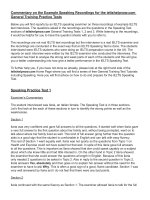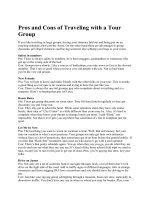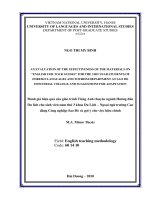Tour Commentaries
Bạn đang xem bản rút gọn của tài liệu. Xem và tải ngay bản đầy đủ của tài liệu tại đây (342.44 KB, 15 trang )
English for Tourism page 18
Unit 4
Tour Commentaries
Section 1
Language Focus
Guiding language
Indicating position
On your right is
On your left is
In front of you is
We are now passing
You can now see
the beautiful …..
the magnificent ……
Superlatives
…… is one of the finest
most famous
most beautiful
buildings
sights
in the world.
in Asia.
in Vietnam.
Passives
….. was built
…… was painted
…… was designed
…. is said to
by …(person).
in … (date)
be haunted
be the best example of …..
have lived here.
Present perfect
……... has stood here for ... (time period)
has been standing since …(date).
PRACTICE
1. Use the following notes to write into full sentences about St Paul’s Cathedral in
London.
a. On/left/beautiful/St Paul’s Cathedral.
…………………………………………………………………………….
b. Stood/over 300 years.
…………………………………………………………………………….
c. Designed/Christopher Wren.
…………………………………………………………………………….
d. One/large/dome/world.
…………………………………………………………………………….
e. Said/influenced/design/Capitol building/Washington.
…………………………………………………………………………….
f. Lord Nelson/buried/crypt.
…………………………………………………………………………….
2. Quiz
English for Tourism page 19
Work with a partner and do the following quiz.
1. The Parthenon was dedicated to ________
A. God Poseidon B. Goddess Athena C. Both A. and B. D. None of these
2. The Parthenon was built almost 2,500 years ago in the country of ________.
A. Greece B. Rome C. New York D. London
3. In which city is the Parthenon situated?
A. Alexandria B. Athens C. Crete
4. How tall is the Eiffel tower?
A. 1834 yards B. 1800 ft C. 1643 ft D. 984 ft
5. How long did it take to build this structure?
A. 2 years and 2 months B. 3 years and 3 months C. 4 years and 4 months
6. St. Peter’s is a _____.
A. church B. castle C. citadel
7. St. Peter’s was completed in ________ under Paul V.
A. 1576 B. 1615 C. 1763
3. Listening
a. Listen to the guides giving commentaries at three places. Mark the statements
T(True) or F(False).
(Adapted from a listening exercise in Going International, 1998)
Commentary 1
a....... The structure is 300 meters high.
b....... It was built in the 18th century.
c....... The British have a similar structure.
Commentary 2
d....... The guide is taking about a square.
e....... The church was built during 100 years.
f....... The tourists will climb up to see the city.
Commentary 3
g....... The building is 2000 years old.
h....... It was built as a Christian church.
i....... It has been destroyed a lot.
b. Listen again. In which commentary do you hear the following adjectives? Write the
numbers (1, 2, 3) on the line.
a.............. Advanced
b.............. Long
c.............. Magnificent
d.............. Proud
e.............. Splendid
f.............. Wonderful
c. What do the guides talk about? Write the number (1, 2 or 3) in the box.
Parthenon
Eiffel Tower
St Peter’s
English for Tourism page 20
English for Tourism page 21
Section 2
Reading
1. Pre-reading
a. Where did you go on your last vacation?
b. How did you go?
c. Who did you go with?
d. What did you see and do?
e. What did you buy as a souvenir?
2. Reading
CITY TOURS
On the day of their city tour, the Silver wakes early. When Mr. and Mrs. Silver
leave the coffee shop, the concierge greets the Silvers with a smile. The concierge
gives Mr. Silver the tickets for the tour and says, "I'm not busy at the moment. Let me
walk with you to where the bus will pick you up. I'll introduce you to the tour guide
personally."
Soon the tour bus stops at the curb. The driver opens the door and the tour
guide climbs down. As he has promised, the concierge introduces each member of the
family to her.
She says: "Welcome. I'm Francine Miller, your guide for this tour. I'll tell you
all about the things you will see. If you have any questions, please ask. It's my job to
answer them. All my time is free to talk to you sightseers." Sights are places or things
to see. Sightseers are people who go to see these sights, or places of interest. Local
tours are sometimes called sightseeing tours.
When the Silvers board (get on) the bus, Mrs. Miller introduces them to the
driver. Then she takes them to the seats that were reserved (saved) for them. When
they are all comfortably seated, the driver starts the bus.
Before the driver became a tour bus driver, he spent many years driving a taxi.
In that way, he learned all the streets of his city. He is an experienced driver, which
means that he has had practice driving in many different or difficult situations, and
drives safely and well. In addition to knowing all the streets, he also knows all the
traffic regulations. Only the most experienced drivers can get jobs on tour buses. He
has also been specially trained to drive a tour bus. He drives carefully past the places
that tourists want to see. He is also careful to avoid stopping suddenly or speeding up
quickly.
People have confidence in a careful driver. Confidence means that they believe
the driver does his or her job well and safely. Passengers feel comfortable riding with a
driver in whom they have confidence. The driver feels that making passengers
comfortable is an important part of his job.
As the bus moves through the city streets, the guide tells the sightseers about
the places and buildings they are passing. They pass a large group of low buildings
English for Tourism page 22
surrounded by a park. "That's a medical center with many different hospitals. The long
low building with the playground next to it is a children's hospital."
The children ask if there are many sick people in the country. Mrs. Miller
replies: "Every country has sick people. I don't know if we have more or fewer sick
people than anywhere else. But I do know that we are very lucky to have such a fine
medical center to help people get well."
When Mr. Silver asks how many other hospitals or medical centers there are in
the country, Mrs. Miller is able to tell him. An important part of her job as a tour guide
is to answer the questions people ask. Another part of her job is to explain the history
of parks or monuments they pass.
After about 40 minutes of such sightseeing, the bus stops in front of a large,
modern building. "This is our national museum," says the guide. "You will find many
interesting works of art and historical displays inside. As you leave the bus, I'll give
you a brochure that will tell you about the museum."
"Is it in English?" Tommy asks.
"May we keep it as a souvenir?" Janet asks.
Mrs. Miller answers yes to both questions and continue: "Inside you will find
signs in English telling about the exhibits. You will also find a display called a
diorama, a small-sized model of the entire city and the countryside around it. Around
this diorama are several telephones. Pick up one of the phones marked 'English' in
order to hear a description of the city. You will also hear about some of the places we
saw on the way here. In addition, the recording will tell you about some of the exhibits
in the museum and some of the places we will see later this afternoon."
As they leave the bus, Mrs. Miller tells the sightseers: "You have one hour to go
through the museum. Then we'll meet back at the entrance. I'll take you to the museum
restaurant where we'll have lunch."
As the Silvers are leaving the museum after lunch, Janet asks the tour guide,
“Can we stop for a moment? I want to buy some postcards to send to my friends. The
stamps in your country are so pretty.”
Each member of the family buys several postcards at a sales counter just inside
the front door of the museum, near the diorama. Then Mrs. Silver asks: “Would you
mind taking the pictures of us standing on the front steps of the museum?”
Tour guides often receive this type of request. Tourists like to have pictures of
themselves visiting faraway places. The tour guides are often asked to take the pictures
so that the whole family or group can be in the photograph.
During the afternoon, the tour goes to a large crafts market. Built by the
government, the market contains many stalls (enclosed spaces) where people display
(show) and sell handicraft items, clothing, and souvenirs. The family walks around the
market. They stop and look at many items. Suddenly, all four members of the family
have the same idea at the same time, buying some shirts as souvenirs.
Back on the bus, the family agrees that they have enjoyed every bit of the tour.
They will take home memories of a pleasurable, interesting day. The souvenirs they
bought will remind them of the pleasurable experiences they had.
(Adapted from English for the Travel Industry by Benedict Kruse and Bettijune Kruse,
1982)
English for Tourism page 23
Work in groups and answer the following questions.
a. Why are local tours sometimes called sightseeing tours?
_____________________________________________________________________
_____________________________________________________________________
b. Why does Mrs. Miller tell the sightseers to ask her any questions they have about
the places they see?
_____________________________________________________________________
_____________________________________________________________________
c. How did the driver get the experience to become a tour bus driver?
_____________________________________________________________________
_____________________________________________________________________
d. What gives people confidence in a driver?
_____________________________________________________________________
_____________________________________________________________________
e. Why do tourists ask a tour guide to take their photographs?
_____________________________________________________________________
_____________________________________________________________________
_____________________________________________________________________
3. Vocabulary
a. Choose the correct word or phrase to complete each sentence.
1. An________ driver has practice driving in many different situations.
a. ordinary c. experienced
b. unusual d. unsafe
2. Because the Silvers feel ________ that the driver is doing his job well, they have
him.
a. an interest in c. nervousness about
b. a concern about d. confidence in
3. A tour bus driver must know all the traffic ________.
a. signs c. regulations
b. streets d. police officers
4. Local tours are sometimes called ________.
a. bus trips c. museum tours
b. sightseeing tours d. city trips









